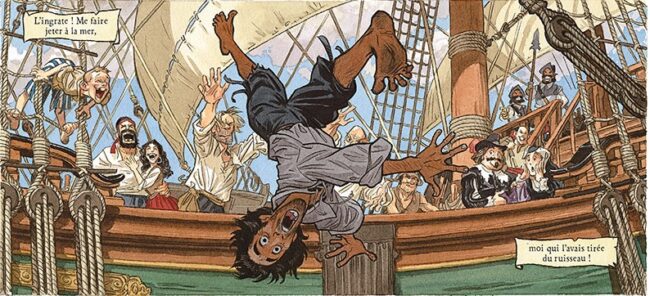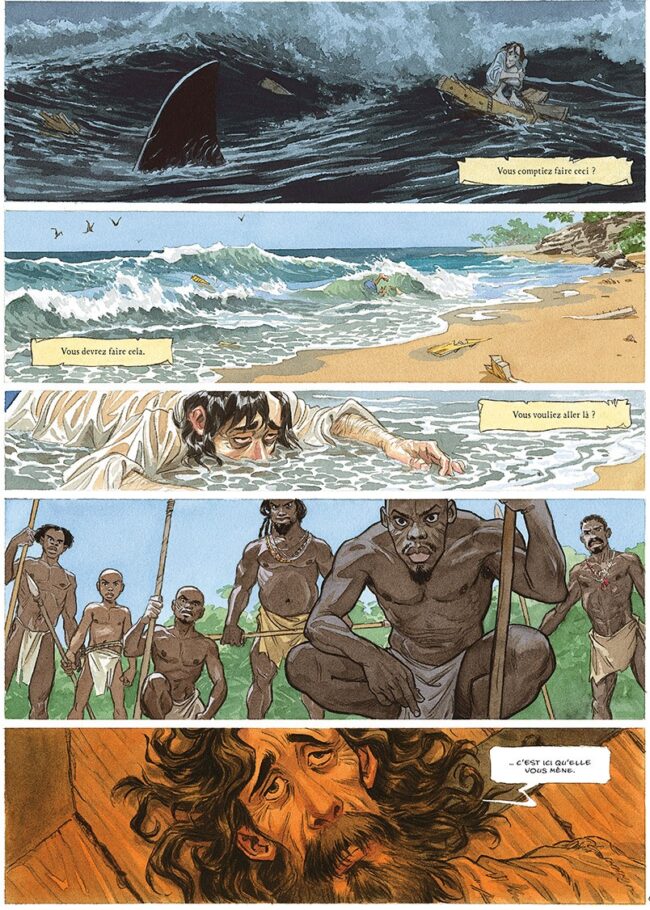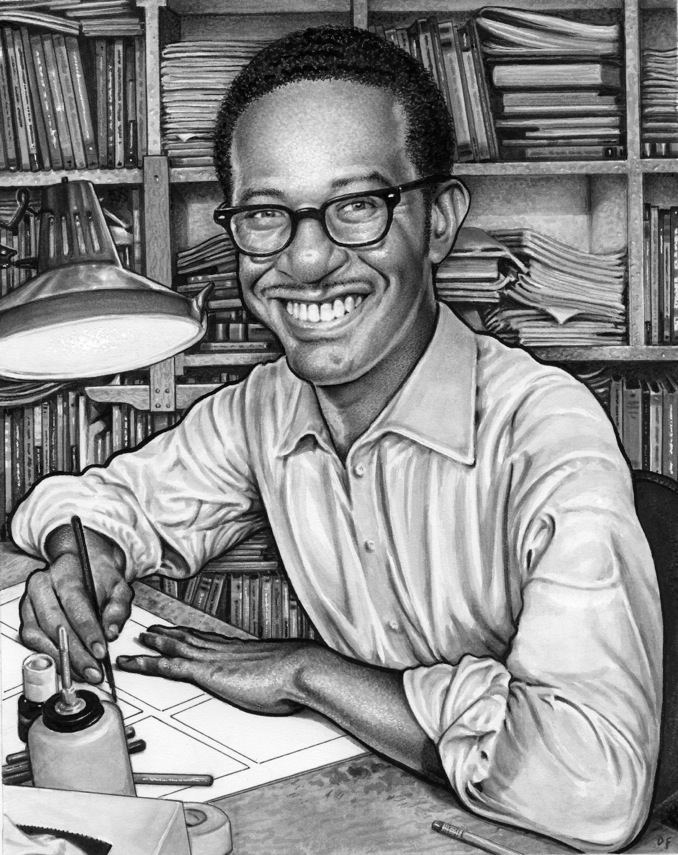 A few weeks before lockdown I witnessed the limited-edition version of Les Indes Fourbes (The Treacherous Indies) being packed for shipping, as I passed through the offices of boutique French publisher, Editions Caurette. The luxuriously finished 208-page oversize volume, measuring 17.5 x 12 inches, signed by the authors, and filled with mouth-watering extras carried the eye-watering price of 330 Dollars. Well out of my price range. In fact, well out of the range of what anyone but serious collectors would consider a reasonable price for a comic book, especially one that had yet to achieve ‘classic’ status, given its 2019 publishing date. Yet, when I asked how sales were going, I was met with wry smiles - because all 499 copies had already been sold. I will let you do the math.
A few weeks before lockdown I witnessed the limited-edition version of Les Indes Fourbes (The Treacherous Indies) being packed for shipping, as I passed through the offices of boutique French publisher, Editions Caurette. The luxuriously finished 208-page oversize volume, measuring 17.5 x 12 inches, signed by the authors, and filled with mouth-watering extras carried the eye-watering price of 330 Dollars. Well out of my price range. In fact, well out of the range of what anyone but serious collectors would consider a reasonable price for a comic book, especially one that had yet to achieve ‘classic’ status, given its 2019 publishing date. Yet, when I asked how sales were going, I was met with wry smiles - because all 499 copies had already been sold. I will let you do the math.
You are probably familiar with illustrator Guarnido thanks to his collection of four Harvey and three Eisner awards for the Blacksad series (Dark Horse), as well as his credits on a bunch of Disney animation features. However, do not expect to find the English version of Les Indes Fourbes at your local comics store just yet - because no US publisher has, thus far, acquired the rights. This seems odd, given Guarnido’s credentials, odder still when you consider how well it has been received in Europe.
Part of the book’s European success can be attributed to the fact that this is Guarnido’s first release since Blacksad: Amarillo in 2013, and rumors of his ‘dream-team’ pairing with writer Alain Ayroles had been circulating since 2009, which meant Les Indes Fourbes was perhaps the most hotly awaited title of 2019, if not the decade, in France. It was always going to sell given both authors’ following and fanbases.
So - is it any good?
 While many feared pre-release hype would lead to disappointment, it has been largely well received by critics and fans alike. In fact, by the time the annual international comics festival at Angouleme (France) had come around, about six months after publication, Les Indes Fourbes had already picked up the Prix Landerneau, the RTL Grand Prix for comics and the French comic-booksellers’ prize, while also making the top-10 bestsellers list for 2019. It has been nothing short of a hit.
While many feared pre-release hype would lead to disappointment, it has been largely well received by critics and fans alike. In fact, by the time the annual international comics festival at Angouleme (France) had come around, about six months after publication, Les Indes Fourbes had already picked up the Prix Landerneau, the RTL Grand Prix for comics and the French comic-booksellers’ prize, while also making the top-10 bestsellers list for 2019. It has been nothing short of a hit.
The story behind the book began in 2005 when writer Ayroles met cartoonist Guarnido and shared his idea for a sequel to Cervantes classic Don Quixote. However, by the time the proposal for their first joint venture together landed on the desk of publisher Guy Delcourt, some ten years later, it was for a tale based on an entirely different Spanish classic. Les Indes Fourbes is billed as the second part of El Buscón (The Swindler) by Francisco de Quevedo, published in 1626, a Spanish novel narrated by lovable rogue Don Pablos whose aim in life is to learn good virtue and become a gentleman. He fails miserably at both however and departs for the Spanish West Indies at the end of the book (where - he says - things did not go any better). Les Indes Fourbes starts with Don Pablos’ arrival in the New World and the comedy of events that unfold.
From the outset it was intended as a ‘one-shot’ album - as neither artist wanted to commit to an open-ended saga. However, what began as an 80-board project gradually ballooned into a 160-page epic which took a full 3 years to complete, forcing Delcourt to delay publication (and the fans’ gratification).
 The plot takes inspiration from 1973 movie The Sting, starring Paul Newman and Robert Redford, and unfolds with echoes of the 1626 tale (El Buscón). Intriguing at the outset, the story twists its way through to a pleasing and surprising conclusion, and it is a perfect comedy - in the classical sense of the word. The humor preys on a critical view of 17th century values, with racism, slavery, greed, religion, and class prejudice forming the setting for Don Pablos’ continuing tale.
The plot takes inspiration from 1973 movie The Sting, starring Paul Newman and Robert Redford, and unfolds with echoes of the 1626 tale (El Buscón). Intriguing at the outset, the story twists its way through to a pleasing and surprising conclusion, and it is a perfect comedy - in the classical sense of the word. The humor preys on a critical view of 17th century values, with racism, slavery, greed, religion, and class prejudice forming the setting for Don Pablos’ continuing tale.
Stylistically, author Ayroles cites the sitcom “How I met your mother” as a source of inspiration, playing with chronology and perspective throughout the book in similar fashion to the popular CBS series. Cultural references abound too: the keen eye will spot Murillo’s “The young beggar” hanging in the background as well as faithful renderings of “The Ladies-in-waiting” and “Sebastián de Morra”, King Philip IV’s court jester - as painted by Diego Velázquez. All acutely rendered thanks to Guarnido’s deft hand.
Guarnido's drawings are dynamic and detailed, and many are worthy of lengthy contemplation. Energetic characters act upon rich backdrops featuring 17th century ships with all their rigging, imposing waterfalls flowing through Amazonian jungles, or blood-thirsty cavalry charging down indigenous soldiers. Extensive ‘silent’ sequences also attest to Guarnido’s talent for visual narration.
Praise for the book has not been wholly without reservation. Beyond price-point and format objections, some feel that the artwork falls short of the benchmark set by Guarnido with the noir Blacksad series, whose oil-painted frames of animal-headed characters are simply jaw-dropping in their detail and expressivity. Fourbes differs primarily because it is rendered in ink and watercolor (and all the characters have human heads). Presumably anticipating possible dissatisfaction among the fanbase, Delcourt quickly followed up the book’s release with a collectors’ black and white edition, which some say is superior. Caurette’s luxury edition is also in black and white for the purists.
There has also been some discussion over the choice of cover image, reminiscent of Frans Hals’ painting of the Laughing Cavalier (1624), which does little to allude to the adventures inside; but then “One picture does not a comic book make” to quote the late Kim Thompson (TCJ 48, 1979).
As for the scenario, while some have expressed disappointment that it falls short of Ayroles best writing, readers have approved overall. “His pen is lively, his dialogues sharp and his vocabulary rich.” says J. Milette on BDGest. It is hard to disagree.
I have long been a fan of Ayroles. In France he is best known for De cape et de crocs (The Swashbucklers) a 12-volume collaboration with illustrator Jean-Luc Masbou, which follows the adventures of two characters reminiscent of Dumas' Three Musketeers. His other big success was a 6-part Shrek-like fairy-tale with illustrator Bruno Maïorana called Garulfo. Both series’ are a real hoot; fast-paced action collides with silliness, situation comedy, jokes, plot twists and visual gags - and both were huge sellers for Delcourt.
It is easy to see why many BD fans in France saw his pairing with Guarnido as the forming of a sort of comic book ‘dream team’. Perhaps now, that 330 bucks is starting to sound a little more reasonable? The crime is that none of Ayroles work has been translated into English yet, unlike his collaborator on Fourbes. This is probably due in part to Delcourt’s lackluster foreign rights department which has succeeded in selling English rights to only a handful of titles over the past twenty years or so. Their latest foreign rights catalogue dates from 2014.
Another explanation could be the fact that the sheer quantity of European titles on offer to US houses every year is such that buyers are overwhelmed by choice. Unfortunately, most French publishers do not bother to translate their key titles into English before attempting to sell them, fearing it will be money wasted, meaning purchasing decisions are often based on the artwork rather than the writing. Clearly, understanding the excellence of a writers’ craft becomes much more difficult if the text accompanying the illustrations is in a foreign language.
French Emperor Napoleon Bonaparte was once quoted as saying « Un bon croquis vaut mieux qu'un long discours » which is often paraphrased as “A picture is worth a thousand words”. Unfortunately for Ayroles, the motto does not always hold true. Fortunately, while we wait for the English version (if it ever comes), the original non-luxury, French, color, version is available at an entirely reasonable 41 Dollars.






